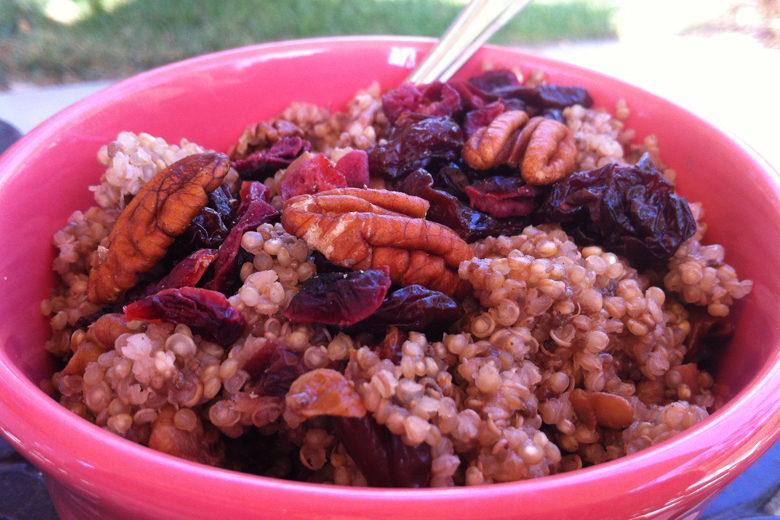
There are so many fallacies out there regarding carbohydrates. You can thank the low-carb, high-protein diet craze for fueling our seemingly unending confusion about carbohydrates and the associated impacts on our health.
Despite the confusion surrounding carbs, it’s true that most health experts agree on one thing: Our penchant for refined grains, such as white flour, is feeding into our nation’s health problems. In fact, the International Scientific Consensus Summit on Glycemic Index, Glycemic Load and Glycemic Response recently reported that strong evidence links heavily refined carbs with type 2 diabetes, heart disease and being overweight. And refined grains are poured into all sorts of products from cereals to bread, and are often packed with other undesirable ingredients such as added sugar and added fats (think: packaged pastries, such as cookies and cakes).
But don’t throw the baby out with the bath water. While it’s true that highly refined carbohydrates may be increasing our risk of diseases, intake of whole grains actually leads to health promotion, such as weight loss, lower risk of heart disease and longevity. Whole grains — an intact grain or seed with an outer bran layer, endosperm layer, and an inner germ layer — not only provide carbohydrates, they are packed with antioxidants, phytochemicals, vitamins, minerals, fiber and even protein. In fact, healthy whole grains form the foundation for entire traditional diets, from quinoa in Peru to millet in Africa.
With September marking Whole Grains Month, this is the perfect opportunity to embrace whole grains whole-heartedly. Try to make at least half of your daily grains whole grains.
Try one of my top five tips for boosting your intake of whole grains:
1. Don’t be afraid to try a variety of whole grains: amaranth, barley, brown rice, buckwheat, bulgar, corn, millet, oats, quinoa, rye, sorghum, teff, wheat (including Kamut, farro and spelt) and wild rice.
2. Make a big pot of your favorite whole grains at the beginning of the week to have on hand to toss into soups, stews, salads or simply use as a side dish.
3. Start the day with a bowl of whole grains for breakfast. While steel cut oats are always a popular choice, you can get exotic by cooking wild rice, quinoa or millet and pairing a hearty serving with dried nuts and fruit. Try my recipe for Ruby Quinoa Breakfast Bowl below.
4. Switch it up. Pass on the refined grains in your diet, which may be hiding in breads, cereals, snack foods, bagels, muffins, pasta and side-dish mixes. Look at the ingredients list and identify whole grains, such as oats or whole wheat, as the first ingredient.
5. Load up on whole grains in your favorite recipes. Stir oats into muffins and even veggie burgers. Use whole wheat flour in homemade breads and cookies. Substitute brown rice to replace white rice in your favorite casserole or stir-fry.
Ruby Quinoa Breakfast Bowl
Recipe by Sharon Palmer, RD
Makes 4 servings
This deep red breakfast bowl — rich in health-protective anthocyanins, as well as protein, fiber, vitamins, and minerals — will fuel you until lunchtime. It’s based on an ancient Peruvian staple, quinoa, which comes in a variety of colors, such as red, white, and black. Legend has it that this hearty ancient grain gave stamina to Incan warriors long, long ago. I think you’ll find its nutrient lineup does the same for you, too.
Ingredients
1 cup uncooked red or white quinoa
2-1/2 cups water
1/4 cup dried cranberries
1/4 cup dried cherries
1/2 cup chopped pecans
1 tablespoon chia seeds
1/2 teaspoon ground allspice
1/2 teaspoon ground nutmeg
Instructions
- Stir together all the ingredients in a small pot, bring to a boil, cover, and cook, stirring occasionally, over low heat until the grain is tender and the liquid is absorbed, about 15 minutes.
- Serve this cereal with plant-based milk, as desired.
Note: Make a whole batch of this cereal ahead of time, store in the refrigerator, and reheat in small batches later. Reserve the pecans until just before reheating to avoid softening. For a creamy finish, try stirring in a little plant-based milk at the end of the cooking time.
Nutritional Info per serving (about 7/8 cup per serving): Calories: 330; Carbohydrate: 47 g; Fiber: 5 g; Protein: 8 g; Total fat: 14 g; Saturated fat: 1 g; Sodium: 12 mg; Star nutrients: Pantothenic acid (10% DV), potassium (15% DV), magnesium (31% DV)

